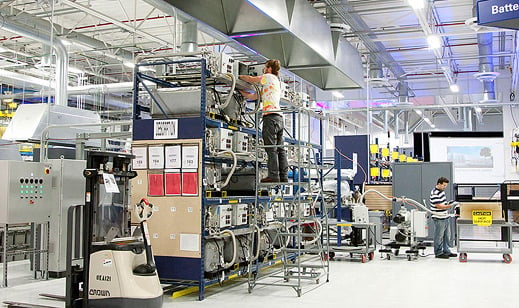An Internet for Manufacturing
What is the industrial Internet?

As good a place as any to find the answer is at General Electric’s newest U.S. factory, a $170 million plant it opened in Schenectady, New York, last July to produce advanced sodium-nickel batteries for uses that include powering cell-phone towers (see “GE’s Novel Battery to Bolster the Grid,” “Inside GE’s New Battery Factory,” and “Can We Build Tomorrow’s Breakthroughs?”).
The factory has more than 10,000 sensors spread across 180,000 square feet of manufacturing space, all connected to a high-speed internal Ethernet. They monitor things like which batches of powder are being used to form the ceramics at the heart of the batteries, how high a temperature is being used to bake them, how much energy is required to make each battery, and even the local air pressure. On the plant floor, employees with iPads can pull up all the data from Wi-Fi nodes set up around the factory.
In November, GE announced it would invest $1.5 billion in efforts to fine-tune its machines’ performance and capture big efficiency gains by connecting them to its enterprise software and to the wider Internet (see “General Electric Pitches an Industrial Internet”). Although the idea of networking machinery isn’t new, GE thinks that cheaper computing power and sensors are now poised to usher in a new era of big data for industry. Jeff Immelt, GE’s CEO, has called the idea a revolution, and the company’s top economist has suggested it could help increase worker productivity by as much as 1.5 percent a year.
Those are big claims, and GE’s heavy spending at Schenectady was meant partly to show off its plans. Every part that goes into the batteries gets tracked with serial numbers and bar codes; if managers want to assess how much energy it took to make a specific battery part and compare it with the average, or study a day’s production, they can do ad hoc analyses on powerful workstations. “I’ve never been able to do that before,” says Randy T. Rausch, business analytics and manufacturing information leader at GE Energy Storage.
The sensor data has yielded some useful insights, says Rausch, including the finding that some battery parts failed quality tests after spending too much time on the manufacturing line. GE now tracks how long these parts “soak” in the factory’s ovens and how much time they spend elsewhere on the production line; alarms flash near parts approaching their limit.
With its push for the industrial Internet, GE may find it’s selling an idea that some manufacturers aren’t convinced is really new. Down the road from GE’s Schenectady plant, in Cohoes, New York, manufacturer Mohawk Fine Papers already monitors how much energy its machines use, pulling together the data in an analytics program it bought from a company called OSISoft. “A lot of the basics of what we’re talking about have been available to companies for years,” says Kim E. Osgood, Mohawk’s director of engineering and energy services.
Osgood says Mohawk recently started to monitor a specific vacuum pump used in its paper making. It knows that over time, calcium builds up on the pump and causes it to consume more energy. Mohawk, using data it has gathered over the last decade, has now set things up so the pump sends out alerts on the calcium levels. But the technology isn’t new, Osgood says; “We just decided to implement it.”
GE will need to show the benefits of bigger networks and more data, something Rausch is working on in Schenectady. The battery factory has more than 100 air pressure, humidity, and temperature sensors, and Rausch now hopes to use weather forecasts to control how much outside air the HVAC system lets in. Since temperature and humidity can affect batteries, Rausch says, “we’d like to take advantage of weather forecasting to be able to know when the humidity is changing and open and close the vents sooner.”
The industrial Internet is now really more of an intranet—most data never leaves a factory or a company’s firewall. But eventually, says Rausch, the idea is to track batteries even after they leave the plant, using embedded computer chips. Other GE divisions, including one in Kentucky that builds appliances, have similar plans for keeping tabs on people’s refrigerators and dishwashers.
With what GE knows about every washing machine and battery it sells—what day it was made, how it was made, who made it, its entire genealogy—the goal will be to draw connections between products that perform better or worse in actual use and the exact conditions under which they were manufactured.
Those links, the ones between the outside world and the factory floor, could ultimately be the most valuable. “It’s where we want to end up in a couple of years,” says Rausch.
Keep Reading
Most Popular
Large language models can do jaw-dropping things. But nobody knows exactly why.
And that's a problem. Figuring it out is one of the biggest scientific puzzles of our time and a crucial step towards controlling more powerful future models.
The problem with plug-in hybrids? Their drivers.
Plug-in hybrids are often sold as a transition to EVs, but new data from Europe shows we’re still underestimating the emissions they produce.
Google DeepMind’s new generative model makes Super Mario–like games from scratch
Genie learns how to control games by watching hours and hours of video. It could help train next-gen robots too.
How scientists traced a mysterious covid case back to six toilets
When wastewater surveillance turns into a hunt for a single infected individual, the ethics get tricky.
Stay connected
Get the latest updates from
MIT Technology Review
Discover special offers, top stories, upcoming events, and more.